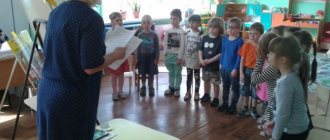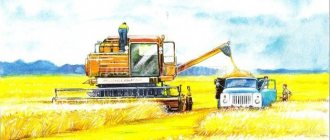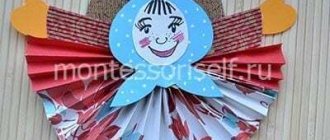Summary of educational activities for speech development in the middle group “Red spring with flowers”
Summary of GCD
on speech development in the middle group
"Red spring with flowers"
Summary of GCD
on speech development in the middle group “Red spring with flowers”
Purpose: Getting to know spring and summer flowers
Tasks:
1.Remember the name of the flowers, the features of their structure.
2. Continue to develop coherent speech, improve the grammatical structure of speech, and activate the subject and verb vocabulary.
3. Foster love and respect for nature.
Material:
a model of a forest clearing, pictures with flowers, a “seven-flowered flower” model, large puzzles with flowers.
Preliminary work:
looking at illustrations of flowers and talking about them. Reading fairy tales: A. Tolstoy “The Scarlet Flower”, “The Seven-Flower Flower”, didactic game: “When does this happen?”
Progress of the lesson:
IN:
Children, look what a beautiful spring flower the sorceress gave me just now. Whoever a leaf from a flower falls into his hand must say any word about spring.
D:
Sun, warmth, grass, flowers, rain, rainbow, buds on trees, puddles.
IN
: Well done. Guys, look, there’s something written on this piece of paper. Yes, this is a letter from the good sorceress. And she invites us to play hide and seek, I will ask riddles, and you guess them, and then we will find out what the sorceress hid from us in the forest clearing.
D:
Let's.
IN:
Listen carefully:
Puzzles
White peas on a green stem.
D:
Lily of the valley
IN:
Rye is earing in the field. There, in the rye, you will find a flower. Bright blue and fluffy, It’s just a pity that it’s not fragrant.
D:
cornflower
IN:
Sisters stand in the meadows - Golden eye, white eyelashes.
D:
Daisies
IN:
Eh, bells, blue, with a tongue, but no bells.
D:
Bells
IN:
The sun is burning the top of my head, wants to make a rattle.
D:
Poppy
IN:
I am a herbaceous plant with a lilac flower. But change the emphasis - And I turn into candy.
D:
Iris
IN:
I turn white like a fluffy ball in a clean field, And the breeze blew - A stalk remained.
D:
Dandelion
IN:
Over the meadow parachutes swing on a twig.
D:
Dandelion
IN:
A sprout breaks through, an amazing flower. It grows out from under the snow, the sun looks and it blooms.
D:
Snowdrop
IN:
The face is fragrant, and the tail is prickly.
D:
Rose
IN:
Cups and saucers do not sink or break.
PHYS.
A MINUTE: “ Our scarlet flowers”
Our scarlet flowers Bloom their petals. (Smoothly raise our hands up.) The breeze breathes slightly, the petals sway. (Swinging arms left and right.) Our scarlet flowers Close their petals, (Squat down, hide.) Shake their heads, (Move their heads left and right.) Quietly fall asleep.
IN:
Guys, what flowers do you like? What do they need to grow? Can you help me tell about this?
Game "Tell about your favorite flower."
(children choose any picture with a flower and tell it).
D:
This is a dandelion, it can be found both in the forest and in the city on the sidewalk. He is one of the first to grow up. Its head is yellow. The stem is round and tube-like. The dandelion will be yellow for a while, and then its head will turn white, etc. (tell the story with the help of the teacher)
IN:
Thank you guys for the interesting stories about flowers.
And now we will hold a competition
Game "Collect the picture"
(children are divided into two teams and collect large puzzles and fix the names of colors)
IN:
Guys, today you were attentive, pleased with your answers, and helped tell us about flowers. I hope the good sorceress heard everything and will please us this spring and summer with a wide variety of flowers.
Get text
Objectives: To clarify and consolidate children’s knowledge and ideas about flowers, where they grow, stages of flower growth and development, to intensify the use of their names in children’s speech. Enrich children's active vocabulary with words - signs and words - actions that characterize a flower at one or another stage of its development. Practice in the formation and use of the genitive plural form of nouns, in the agreement of nouns with numerals. Practice composing images from geometric shapes. Develop coherent speech by teaching children to compose a story based on a series of subject pictures. Develop visual perception and memory, hand-eye coordination, auditory attention, intonation expressiveness of speech. To cultivate a caring attitude toward living nature, flowers, and a desire to admire their beauty. Equipment : subject pictures depicting garden and wildflowers; pictures of forests, meadows, gardens; slides: Flora - goddess of flowers, gardener, elf, wind, primroses; reproductions of still lifes with flowers; audio recording of wind noise, musical piece “Waltz of the Flowers”; bell; set of geometric shapes. Progress of the lesson
The musical work by P. I. Tchaikovsky “Waltz of the Flowers” is playing. Teacher: - Listen to what wonderful music it sounds. Do you like this music? How does it make you feel? (Children's answers) - This piece of music was written by composer P. I. Tchaikovsky, and it is called “Waltz of the Flowers.” This wonderful music invites you and me to the most beautiful, colorful, filled with wonderful aromas, magical land of flowers. The mistress of the land of flowers is called Flora - the goddess of the plant world. (Slide 1) - Here we are in a beautiful flower meadow. Flowers greet us and nod their heads. (Slide 2) These flowers are the very first to bloom in the spring. What are their names? (Primroses) It’s as if they are greeting us. Let us also say “hello” to every flower. (Slides with primroses). (Each child says a greeting to a flower) - Flora collected a bouquet of flowers from different places, but a strong wind blew in and scattered all the flowers. (Slide with wind) (Sounds of wind) Let's help collect them and return them to their places. D/i “What grows where?” - But in this clearing some flowers dropped their petals. What flowers can these petals come from? D/i “Which flower is the petal from” (Blue - ...cornflower, white - ...lily of the valley, chamomile; red - ...rose, tulip; purple - ...violet, bell, yellow - ...narcissus, dandelion, coltsfoot.) “Flowers love it very much when people praise them and say beautiful, pleasant words.” Let's tell them these words. Which flowers? (Beautiful, tender, vibrant, fresh, bright, colorful, fragrant, young, spring, garden, field, large, small) (Slide 2) - In Flora’s basket there are words that will help you find out what a flower can do, what with it happens. These words are actions. I will name the words - actions, and you find the pictures to which they fit: grew, stretched, blossomed, smiled, shone, drooped, faded... - Using such words, you can compose a story about the life of a flower. I'll start, and you continue. (A tremulous flower breaks through the ground. It reached out with all its might to the sun. The flower blossomed, opened its beautiful petals. Smiled at the sun, the earth, the people. For a long time it delighted with its beauty. And then it drooped, lowered its head and withered.)
Visual gymnastics. Look at the guys, Now to the sky - there are birds flying. Below, on the grass, a beetle is crawling, and to the left, a tree is growing. To the right are scarlet flowers, close your eyes and smell them. A butterfly circles above them, and the Big bumblebee buzzes next to it.
— Guys, do you think that a plucked flower is good or bad? (Children's answers) What do you see as good? (Decorates the house. Fills it with a pleasant aroma. Gives joy.) What is the bad thing? (Plucked flowers, especially wild ones, quickly die. If everyone starts picking flowers, there will be no beauty around. There will be no flowers - bees will have nowhere to collect nectar, and butterflies will have no place to collect pollen. Flower seeds will not fall into the ground and new flowers will not grow from them. ) What is more about the fact that we pick flowers: good or bad? (Bad) Which flowers are better to admire? (Those that grow in living nature: in a meadow, in a field, in a forest, in a city flowerbed.) The child reads a poem:
We need to bend over the flowers, not to tear them and trample them, but to see their kind faces and show them our kind face.
— And if you want to decorate your home with a bouquet of flowers, then it is better to use flowers specially grown in greenhouses or in the garden. A kind gardener from the magical land of flowers grew different flowers in his garden and made bouquets from them. Which? Name it yourself. D/i “Name the bouquet.” — And you will find out the number of flowers in the bouquet if you listen carefully. The number of times the bell rings is the number of flowers in the bouquet. D/i “How many flowers are in the bouquet?” — The beauty of flowers has always inspired musicians, artists, poets, and storytellers to create musical works, paintings, poems, and fairy tales. What fairy tales about flowers do you know? Read poems about flowers. Name the works of art that you see. What genre of painting do they belong to? Do you remember what piece of music you listened to at the beginning of class? Which composer wrote it?
Reflection “Bouquet of Moods”.
Speech therapy summary for the middle group on the topic “First spring flowers”
Theme “First spring flowers”
Lesson 3
Correctional educational tasks.
Expansion and clarification of the dictionary on the topic “First spring flowers.” Improving the grammatical structure of speech (formation and use of the plural form of nouns), reading and typing skills, sound-letter analysis.
Corrective and developmental tasks.
Development of visual gnosis and constructive praxis, general speech skills, articulatory, fine and gross motor skills, creative imagination, intonation expressiveness.
Correctional and educational tasks.
Formation of skills of cooperation, interaction, goodwill, independence, initiative, desire to be fair. Cultivating a love for nature.
Equipment.
A container with details of a planar image of a snowdrop, a ball, a pot with a blooming coltsfoot, cards with the letters A, U, O, I, T.
Progress of the lesson
1. Organizational moment.
The speech therapist meets children at the door of the office with a container in his hands.
Children select one snowdrop piece from the container and go to the carpet maker. Speech therapist.
Name the parts of the flower that you took. 1st child. Stem. 2nd child. Flower. 3rd child. Leaf. 4th child. Bud. Speech therapist. Make an image of a snowdrop. Children complete the task.
2. Narrating the poem “Snowdrop”.
The speech therapist invites the children to admire what a beautiful snowdrop they have made, and to tell everyone a poem about it.
Children.
The very first, the most subtle There is a flower with the name tender. Like a ringing drop of hello, It’s called a snowdrop. (Then you can invite the children to take turns reciting the poem.)
Speech therapist. Do you remember that you can’t collect snowdrops in the forest? Why? What will happen if people collect rare flowers? Children. They may disappear. Speech therapist. Right. We will not collect rare flowers in the forest. You can try growing them in your garden. Or you can photograph or draw them.
3. Game “One - Many” (with a ball).
The speech therapist invites the children onto the carpet and takes the ball.
Speech therapist.
And now the ball game “One - Many”. I will name a part of a flower or a flower and throw the ball to one of you. The one who catches the ball must name several of these parts of the flower or flowers. (Throws the ball.)
Stem. 1st child. Stems. Speech therapist. Leaf. 2nd child. Leaves. Speech therapist. Bud. 3rd child. Buds. Speech therapist. Flower. 4th child. Flowers. Speech therapist. Petal. 1st child. Petals. Speech therapist. Snowdrop. 2nd child. Snowdrops. Speech therapist. Crocus. 3rd child. Crocuses. Speech therapist. Primrose. 4th child. Primroses. Speech therapist. Well done! Give yourself a clap.
4. Game “What’s extra?”
The speech therapist invites the children to the table.
Speech therapist. And now the game “What’s extra?” I will name plants or what needs to be done with them, and you will determine which word is superfluous and why. Crocus, cabbage, snowdrop, anemone - what's extra? Children. Cabbage. Speech therapist. Why? Children. This is a vegetable. Speech therapist. What about everything else? Children. These are spring flowers. Speech therapist. Right. Cactus, coltsfoot, snowdrop, crocus - what's extra? Children. Cactus. Speech therapist. Why? Children. It grows at home in a pot. Speech therapist. What about the rest of the plants? Children. In the forest. Speech therapist. Right. Draw, photograph, collect, admire - what word is superfluous? Children. Gather. Speech therapist. Why? Children. Spring flowers cannot be collected. Speech therapist. Right. Well done.
5. Breathing exercises. Exercise
The speech therapist takes a pot with a blooming coltsfoot and invites the children
to go out onto the carpet again.
Speech therapist.
And now a breathing exercise. You should smell the flowers and slowly inhale air through your nose. Then you need to hold your breath, and then, as you exhale, say: “The flowers smell so delicious!” See how I do it. Next, each child performs the exercise under the supervision of a speech therapist.
6. Exercise “Repeat after me.”
The speech therapist invites the children to the mirror and offers to do 1-2 exercises from articulatory gymnastics for whistling sounds, and then takes out cards with individual tasks and asks each child to repeat the text of the task. Children can be assigned to monitor the correct completion of the task by their comrades and evaluate each other’s work.
7. Game “Live sounds”.
The speech therapist gives the children cards with letters.
Speech therapist. And now the game “Living Letters”. I gave you cards with letters. Name them. 1st child. A. 2nd child. U. 3rd child. O. 4th child. T. Speech therapist. Right. And now I will name the syllables. The letters that make up these syllables should come to the board. At, from, ut, ta, then, tu. Children complete the task.
The speech therapist monitors the correctness of its implementation. If mistakes are made, the speech therapist invites the children to correct them themselves. Children can be asked to decide for themselves which syllables should be made.
8. End of class.
[
Assessment of children’s work.]
The speech therapist collects cards with letters, invites the children to sit on chairs and talk about what they did in class, what games they especially liked.



